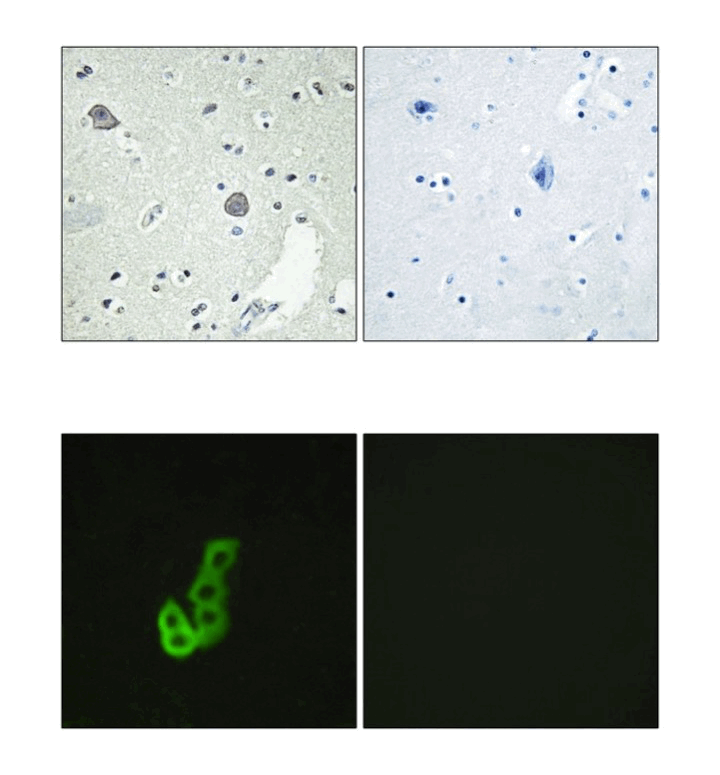Anti-DRD1: Rabbit Dopamine Receptor D1 Antibody |
 |
BACKGROUND Dopamine receptors are a class of metabotropic G protein-coupled receptors that are prominent in the vertebrate central nervous system (CNS). The neurotransmitter dopamine is the primary endogenous ligand for dopamine receptors. There are at least five subtypes of dopamine receptors, D1, D2, D3, D4, and D5. The D1 and D5 receptors are members of the D1-like family of dopamine receptors, whereas the D2, D3 and D4 receptors are members of the D2-like family.1 D1 and D5 are highly homologous and very few ligands have been identified that are selective between the D1 and D5 subtypes. D1 receptors are widely expressed throughout the brain, whereas D5 receptors show a restricted distribution (mainly limbic areas). D1 receptors regulate neuronal growth and development, mediate some behavioral responses, and modulate dopamine receptor D2-mediated events.2
The D1-like and D2-like classes of dopamine receptors each have shared signaling properties. D1-like receptor signaling is mediated chiefly by the heterotrimeric G proteins Gαs and Gαolf, which cause sequential activation of adenylate cyclase, cylic AMP-dependent protein kinase, and the protein phosphatase-1 inhibitor DARPP-32. The increased phosphorylation that results from the combined effects of activating cyclic AMP-dependent protein kinase and inhibiting protein phosphatase 1 regulates the activity of many receptors, enzymes, ion channels, and transcription factors. D1 or a novel D1-like receptor also signals via phospholipase C-dependent and cyclic AMP-independent mobilization of intracellular calcium.3 D2-like receptor signaling is mediated by the heterotrimeric G proteins Galphai and Galphao. These pertussis toxin-sensitive G proteins regulate some effectors, such as adenylate cyclase, via their Gα subunits, but regulate many more effectors such as ion channels, phospholipases, protein kinases, and receptor tyrosine kinases as a result of the receptor-induced liberation of Gbetagamma subunits. In addition to interactions between dopamine receptors and G proteins, other protein:protein interactions such as receptor oligomerization or receptor interactions with scaffolding and signal-switching proteins are critical for regulation of dopamine receptor signaling.4
REFERENCES
1. Loos, M. et al: Cerebral Cortex 20:1064-1070, 2010
2. Foll, B.L. et al: Behav. Pharmacol. 20:1-17, 2009
3. Neve, K.A. et al: J. Receptor Signal Transduct. 24:165-205, 2004
4. Ahlgren-Beckendorf, J.A & Levant, B: J. Receptor Signal Transduct. 24:117-130, 2004
2. Foll, B.L. et al: Behav. Pharmacol. 20:1-17, 2009
3. Neve, K.A. et al: J. Receptor Signal Transduct. 24:165-205, 2004
4. Ahlgren-Beckendorf, J.A & Levant, B: J. Receptor Signal Transduct. 24:117-130, 2004
Products are for research use only. They are not intended for human, animal, or diagnostic applications.
Параметры
Cat.No.: | CG1111 |
Antigen: | Synthesized peptide derived from human DRD1 |
Isotype: | Rabbit IgG |
Species & predicted species cross- reactivity ( ): | Human, Rat, Mouse |
Applications & Suggested starting dilutions:* | WB n/d IP n/d IHC 1:50-1:100 ICC n/d FACS n/d IF 1:100-1:500 |
Predicted Molecular Weight of protein: | 49 kDa |
Specificity/Sensitivity: | Detects endogenous DRD1 proteins without cross-reactivity with other family members. |
Storage: | Store at -20°C, 4°C for frequent use. Avoid repeated freeze-thaw cycles. |
*Optimal working dilutions must be determined by end user.
Документы
Информация представлена исключительно в ознакомительных целях и ни при каких условиях не является публичной офертой








